COLLECTION: Project-Based Learning (PBL) Resources
Project-based learning (PBL), instruction, learning, technology
Project_Planner_v2019_avenir. Project-Based Learning: Benefits, Examples, and Resources. 20 Examples Of Project-Based Learning. 20 Examples Of Project-Based Learning For A Modern World by TeachThought Staff In 13 Brilliant Outcomes Of Project-Based Learning, we gave a quick example of project-based learning to illustrate the relationship between learning objectives and the products and artifacts produced by project-based learning.
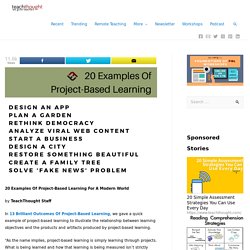
“As the name implies, project-based learning is simply learning through projects. What is being learned and how that learning is being measured isn’t strictly dictated by the project and any products or artifacts within that project. Rather, the reverse should be true: the desired learning objectives should help dictate the products and artifacts within the project.
Top PBL News Stories. Here are some articles, blog posts, research studies, and other resources I’ve recently run across that relate to Project Based Learning.

How Learning Happens Edutopia Check out this wonderful video series, informed by the work of Linda Darling-Hammond of the Learning Policy Institute and Pamela Cantor of Turnaround for Children. Several of the videos connect directly to PBL; all are worth watching. Students Learn From Someone They Love The New York Times This connects to two of our Project Based Teaching Practices, Build the Culture and Engage & Coach: Columnist David Brooks talks about the importance of personal relationships between teachers and students, citing brain research on the connection between positive emotions and learning.
It’s 2019. So why do 21st century skills still matter?
Top PBL News Stories. PBL in a Video Production Class. By Nick Weiss Teacher and Director of Innovative Teaching and Learning, Prince of Peace Christian School (Carrollton, TX) Every time I assign a major video project early in the year in my high school Video Production class, I get a mixed bag of results.
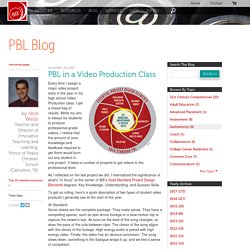
While my aim is always for students to produce professional-grade videos, I realize that the amount of core knowledge and feedback required to get there would burn out any student in one project. It takes a number of projects to get videos to the professional level. As I reflected on the last project we did, I internalized the significance of what’s “in focus” at the center of BIE's Gold Standard Project Design Elements diagram: Key Knowledge, Understanding, and Success Skills. To get us rolling, here's a quick description of two types of student video products I generally see at the start of the year. At Standard: Some videos are the complete package.
Approaching Standard: Some videos don't make complete sense.
PBL Is Not Just For Talented and Gifted Students. I had the opportunity to sit in on a PBL breakout session recently at an education conference.
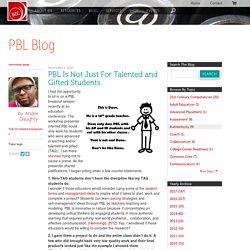
The workshop presenter inferred PBL could only work for students who were advanced in learning and/or talented and gifted (TAG). I sat there stunned trying not to cause a scene. As the presenter shared justifications, I began jotting down a few counter statements.
PBL for Life’s Projects. (Ed. note: In our workshops we used to explain PBL by comparing a project to the task of cooking a Thanksgiving dinner.
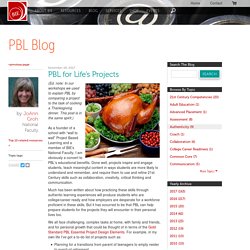
This post is in the same spirit.) As a founder of a school with “wall to wall” Project Based Learning and a member of BIE’s National Faculty, I am obviously a convert to PBL’s educational benefits. Done well, projects inspire and engage students, teach meaningful content in ways students are more likely to understand and remember, and require them to use and refine 21st Century skills such as collaboration, creativity, critical thinking and communication.
Much has been written about how practicing these skills through authentic learning experiences will produce students who are college/career ready and how employers are desperate for a workforce proficient in these skills. But it has occurred to be that PBL can help prepare students for the projects they will encounter in their personal lives too. Sustained Inquiry: Next, I would define the scope of my research.
3 Ways to Manage the Messy Middle of a Project. After the entry event to launch the project, it’s time to start managing the workflow.
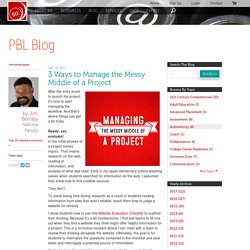
And that’s where things can get a bit tricky. Ready, set, evaluate! In the initial phases of a project comes inquiry. That means research on the web, reading of information, and analysis of what was read. Early in my upper elementary school teaching career when students searched for information on the web, I assumed they knew how to find credible sources. They don’t. To avoid losing time during research as a result of students reading information from sites that aren’t reliable, teach them how to judge a website for veracity.
New Study Shows the Impact of PBL on Student Achievement. Does project-based learning (PBL) raise student achievement? If you’ve been involved in PBL for long, you’ve undoubtedly encountered this question. Over the last few years as education researchers at University of Michigan and Michigan State University, we have worked to address this question through a large study of the effects of PBL on social studies and some aspects of literacy achievement in second-grade classrooms.
Why Project-based Learning Should Rule Your School!
Edutopia. All of the seventh-grade students who gave me cards for Teacher Appreciation Week included the same sentiment: They all thanked me for “allowing” them to choose their own projects, giving them freedom to pursue their learning goals. Most of these comments pertained to 20 percent time, also known as Genius Hour.
Genius Hour is time that students are given to work on projects that relate to both their interests and the curriculum. It’s sometimes called 20 percent time because some corporations (famously Google, at one time) have given employees 20 percent of the workday to follow passion projects. In a classroom, 20 percent time can mean one class period out of five. For me, it’s every Wednesday. Meeting the Standards Over the years, my social studies students have often asked questions like, “When are we going to learn about World War II?” One of the obstacles to adopting 20 percent time in a classroom can be meeting standards. Geeking Out in History Class History Class as Makerspace. 4 Ways to Promote Growth Mindset in PBL. Originally posted on GettingSmart.com.
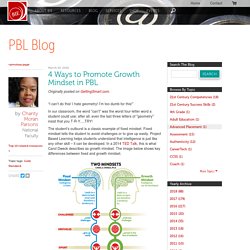
“I can’t do this! I hate geometry! I’m too dumb for this!” In our classroom, the word "can’t" was the worst four-letter word a student could use; after all, even the last three letters of "geometry" insist that you T-R-Y….TRY!
It Takes a System for High Quality PBL. “I was really excited about the project I designed, but then I got back to the reality of my classroom and school.
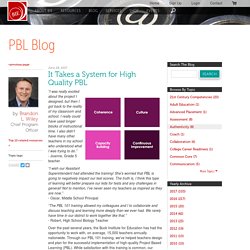
I really could have used longer blocks of instructional time. I also didn’t have many other teachers in my school who understood what I was trying to do.” - Joanne, Grade 5 teacher “I wish our Assistant Superintendent had attended the training!
Why Your Project Needs a Verb. Designing project-based learning (PBL) assignments opens up several decisions.

The challenge that students will face, the assessments that measure their learning, the amount of voice and choice to offer, the calendar and length of the challenge—these are just some of the many facets of an effective PBL project. As we design a project, we may have trouble really focusing it. It might be too big and get out of control in implementation or perhaps too small and not a true PBL experience in which inquiry abounds.
Project Based Learning Resources, Examples.
About ETR Community EdTechReview (ETR) is a community of and for everyone involved in education technology to connect and collaborate both online and offline to discover, learn, utilize and share about the best ways technology can improve learning, teaching, and leading in the 21st century.
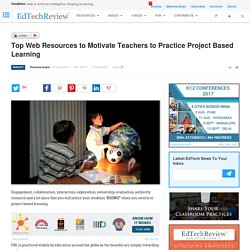
Transformed by Technology and Project-Based Learning: High Tech High. Project Based Learning & iPad Integration. Five Keys to Rigorous Project-Based Learning. Project Based Learning: Explained.
Project Based Learning Resources, Examples. Talking About Text Structure in the PBL Classroom. Project-based learning is often associated with STEM learning, but PBL is a powerful context for literacy learning as well. Many research-supported practices for developing literacy can be seamlessly embedded into projects.
A meaningful and engaging context, as in PBL, can make instruction in research-supported practices even more effective (Guthrie et al., 2004; Guthrie et al., 2008). Strong readers pay more attention than weaker readers to how texts are structured or organized. Fortunately, paying more attention to text structure is something that we can teach to all readers. Research shows that this practice helps many readers, even young children and those with learning difficulties (Gersten, Fuchs, Williams, & Baker, 2001; Shanahan et al., 2010). 1.
Select a text that one or more students are using in a project. 2.
Scaffolding the PBL Shift. I remember my first year teaching freshmen Global Studies at a brand new Project Based Learning school. I was so excited to allow students to pursue their own paths in student centered learning.
L2F_CommonCoreAlignment_2017. Cybrary Man's PBL Resources. I’ve been meaning to write this post after hearing an idea at PBL World 2015 in the keynote by Ramsey Musallam, an amazing speaker and high school chemistry teacher. Now that PBL World 2016 is almost upon us, I thought I’d better get this done so I can be ready to blog about this year’s events and ideas. Ramsey likened the learning cycle that happens in PBL to the classic “hero’s journey” first explained by mythologist Joseph Campbell in The Hero with a Thousand Faces (1949). Campbell described the basic narrative pattern as: A hero ventures forth from the world of common day into a region of supernatural wonder: fabulous forces are there encountered and a decisive victory is won: the hero comes back from this mysterious adventure with the power to bestow boons on his fellow man.
Many myths and stories throughout human history, literature, and in movies follow this pattern, from Odysseus to Buddha to Jesus to fairy tales to Frodo Baggins to Neo in The Matrix and, of course, Star Wars.
PBL School Rubric. A Must Have Rubric for Effective Implementation of PBL in Your School. Designing Research Projects Students (and Teachers) Love. Designing Research Projects Students (and Teachers) LoveMultiMedia Schools, Nov-Dec 1999 Consider these scenarios: Scenario 1:Michael is a wonderful young man. Handsome, intelligent, caring and sweet, he‘s better than about 99% of the rest of kids out there. But the one thing he is not is much of is a scholar. He is diligent, but perfunctory, about his school assignments.On occasion, however, Mike gets very excited about his schoolwork.
Elements of projects that encourage creativity: Scenarios. The quality and effectiveness of school projects differ vastly. Consider the last time you visited an elementary school science fair.
How many of the projects would be considered high quality using Google’s criteria above? I bet the volcano model and the plant nutrient experiment wouldn’t pass muster. Does making a volcano out of paper mache demonstrate the scientific method?
Creativity and project-based learning 2. I am not very good at self-promotion. Minnesota modest, I guess. Yet I also think my new book Teaching Outside the Lines: Developing Creativity in Every Learner may improve kids' lives.
35 Leaders on the Successes and Challenges of Project Based Learning. This post originally appeared on GettingSmart.com.
10 Practical Ideas For Better Project-Based Learning In Your Classroom. 8 Essential Elements To PBL. Supported file types: .doc/.docx, .xls/.xlsx, .ppt/.pptx, .pdf, .jpg, .jpeg, .png, .gif, .bmp Max file size: 25 MB Supported thumbnail types: .jpg/.jpeg, .png, .gif, .bmpMax upload size: 500 kB. 8 Essential Elements of Project Based Learning — Project Based Learning.
If you follow me on Twitter, or have ever read my blog, you know I am a big fan of Project Based Learning (PBL). I firmly believe an emphasis on creative, innovative projects (not the dioramas from our childhood) challenges the current paradigm of education. PBL makes learning relevant, engaging, and authentic. PBL demands and develops 21st century skills like creativity, collaboration, communication, and critical thinking. Whether you are a first-time PBL teacher, or a seasoned practitioner, it is a great exercise to reflect upon the essential components of a meaningful project.
4 Ways to Promote Growth Mindset in PBL. 3 Lessons From Teaching Our First PBL Unit. HQPBL Update: Less Than One Year To Go!
The No.1 Whiteboard App for Every Teacher At School. Ideas And Inspiration For The K-12 Community - K-12 Instructional Resource Center.
PROJECT-BASED LEARNING - Twenty Ideas for Engaging Projects. Using Project-Based Learning To Flip Bloom’s Taxonomy For Deeper Learning -
Projects vs. Project-Based Learning Chart. Flipping Bloom's Taxonomy with PBL for Deeper Learning. Project-Based Learning Through a Maker's Lens. 5 Keys to Rigorous Project-Based Learning. Project-Based Learning.
What the Heck Is Project-Based Learning?
IDEA WATCH: School Libraries, Librarians, and Project-Based Learning–“Flexing” Library Spaces for Learning. An Introduction to Project-Based Learning. What is PBL?










